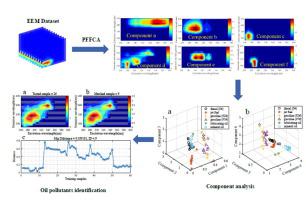Spectrochimica Acta Part A: Molecular and Biomolecular Spectroscopy ( IF 4.4 ) Pub Date : 2021-02-13 , DOI: 10.1016/j.saa.2021.119586 Yaoyao Cui , Deming Kong , Lingfu Kong , Shutao Wang

|
Serious ecological damage can be caused due to increased oil pollution. Identifying the source of oil can inform effective mitigation strategies and policies. A novel method for oil pollutants identification has been presented based on excitation emission matrix (EEM) fluorescence spectroscopy and parallel factor framework-clustering analysis (PFFCA). First, the EEM spectroscopy of the oil samples was measured by a FS920 steady-state fluorescence spectrometer. Second, EEM was analyzed and characterized by PFFCA. A total 90 EEM were decomposed into six components using excitation wavelengths from 260 to 400 nm and emission wavelengths from 280 to 450 nm. Finally, oil samples were classified and matched by using concentration vectors. The results were compared with those obtained by using linear discriminant analysis (LDA) employing parallel factor analysis (PARAFAC) scores, and partial least squares discriminant analysis (PLS-DA). The best classification result was obtained by using LDA employing concentration vectors with 96.7% accuracy. The results indicate that PFFCA-LDA offers a robust approach for the oil samples, which is of great significance in discrimination of oil pollutants.
中文翻译:

激发发射矩阵荧光光谱法和并行因子框架聚类分析法用于油中污染物的识别
油污染的加剧会造成严重的生态破坏。确定石油来源可以为有效的缓解策略和政策提供依据。提出了一种基于激发发射矩阵(EEM)荧光光谱和并行因子框架聚类分析(PFFCA)的油污识别新方法。首先,通过FS920稳态荧光光谱仪测量油样的EEM光谱。其次,通过PFFCA对EEM进行分析和表征。使用260至400 nm的激发波长和280至450 nm的发射波长,将总共90个EEM分解为六个分量。最后,通过使用浓度矢量对油样进行分类和匹配。将结果与通过使用并行因子分析(PARAFAC)评分和部分最小二乘判别分析(PLS-DA)的线性判别分析(LDA)获得的结果进行比较。最佳分类结果是通过使用LDA以及96.7%的精度的浓度向量获得的。结果表明,PFFCA-LDA为油样提供了一种可靠的方法,这对区分油污污染物具有重要意义。



























 京公网安备 11010802027423号
京公网安备 11010802027423号